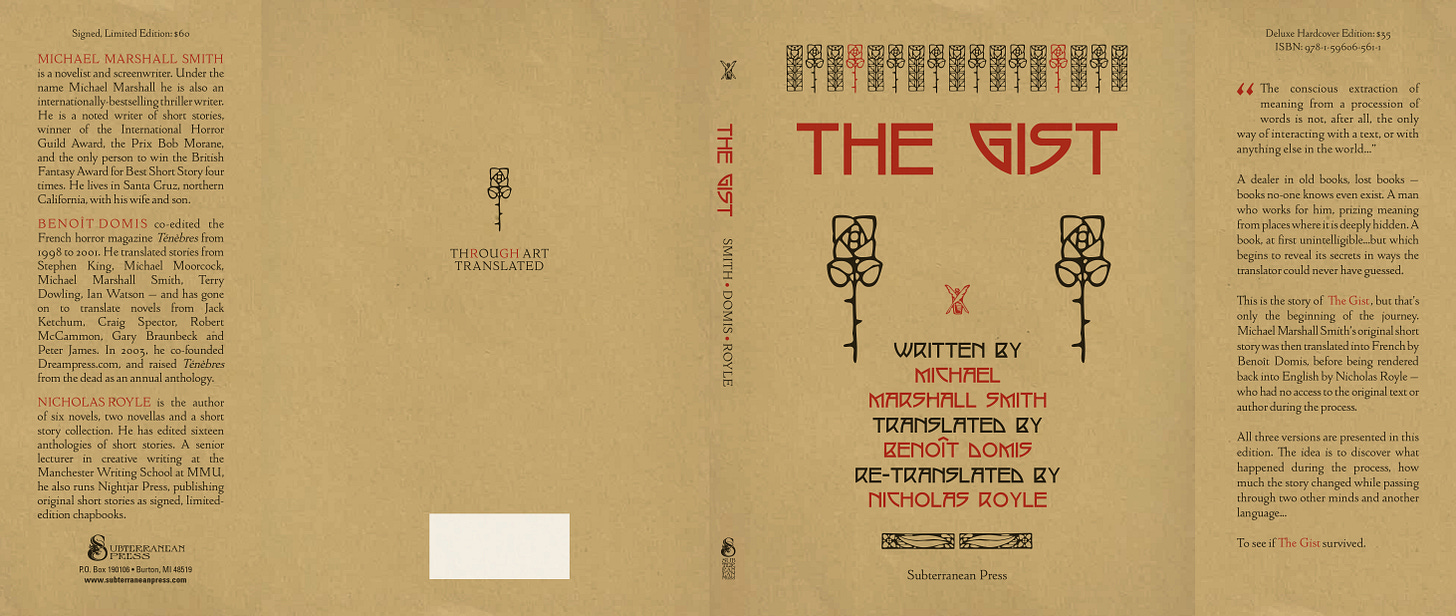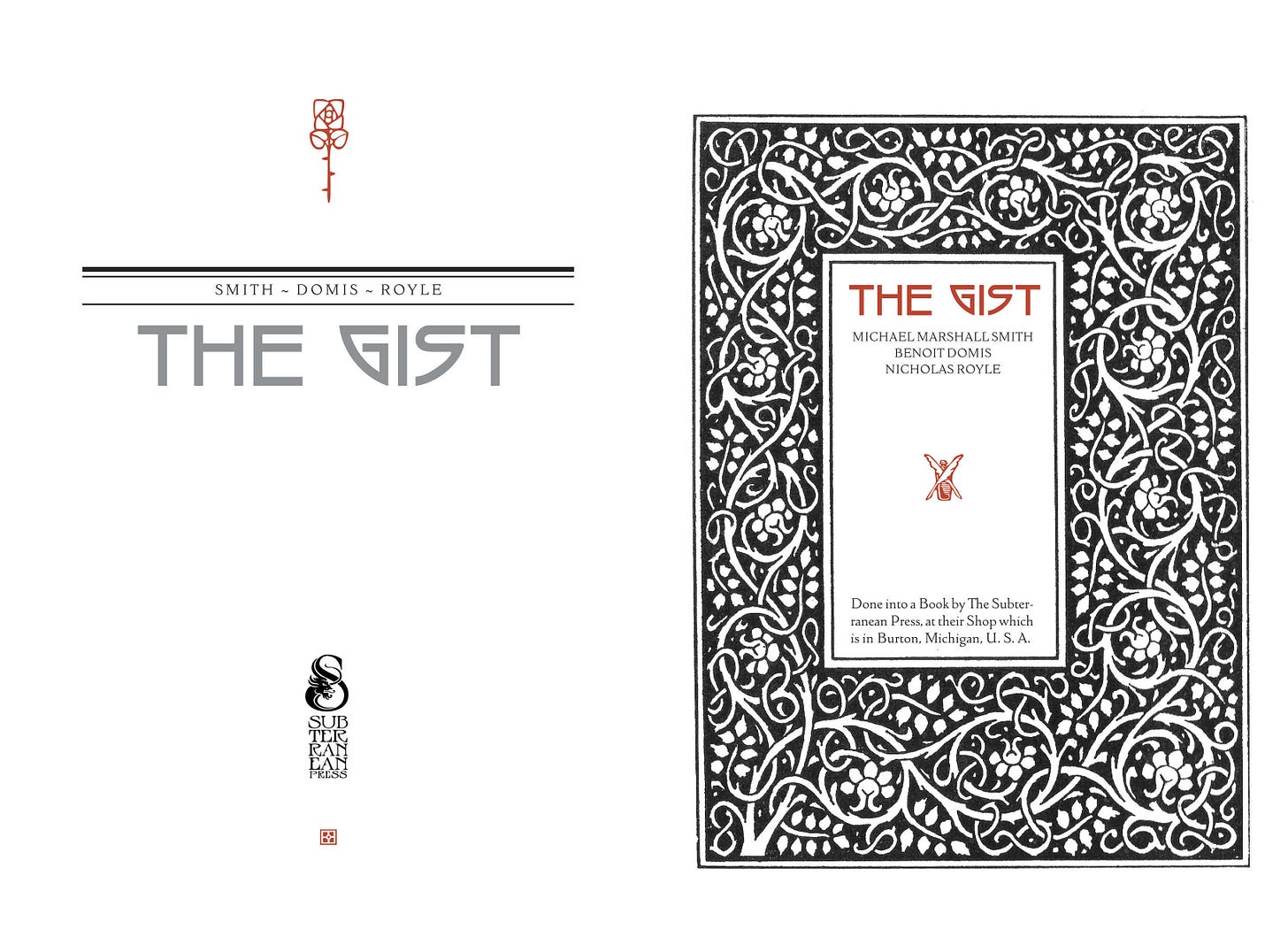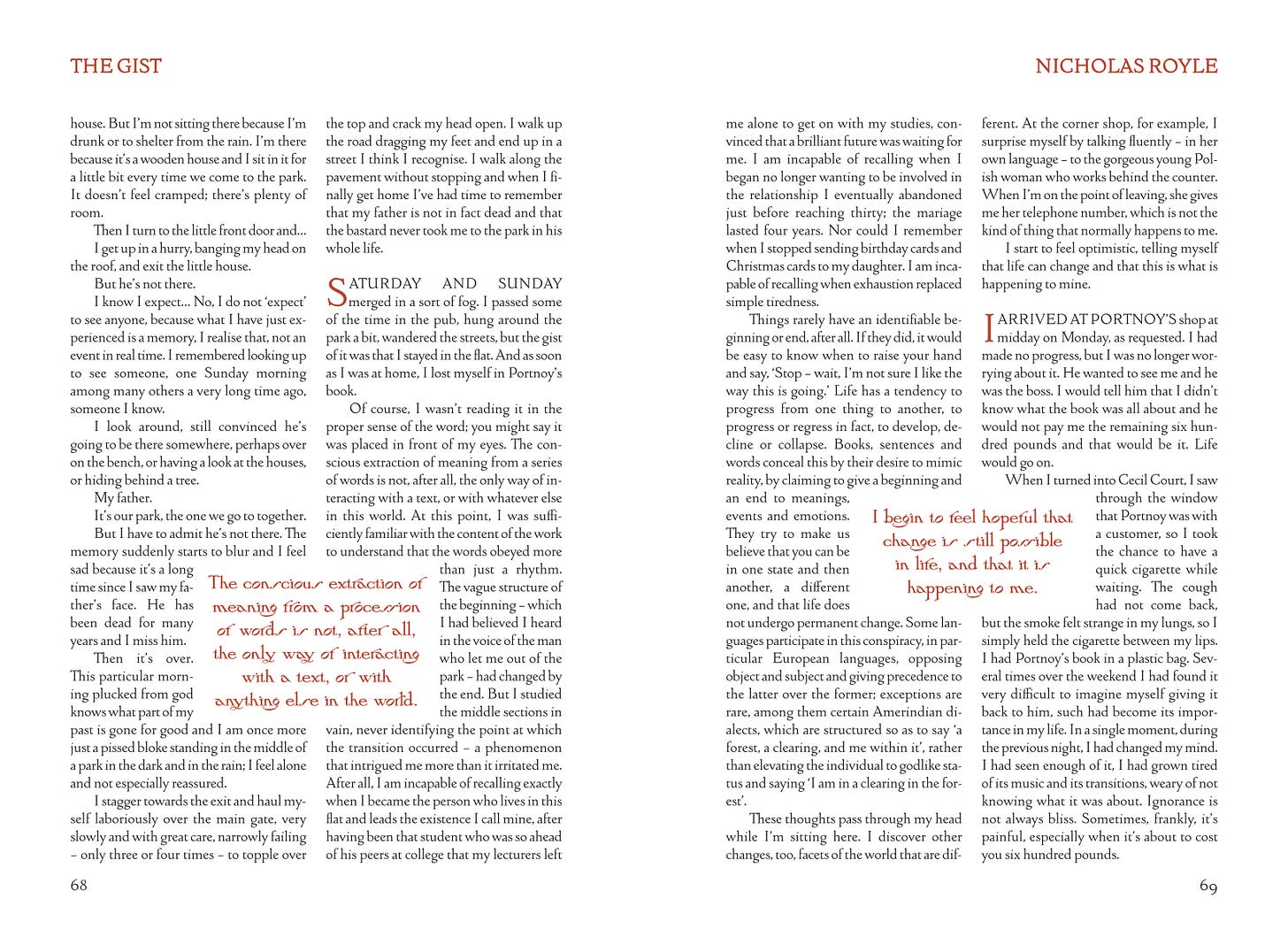The Gist
When you're glad you did something
This post is about something I wrote and did. It’s not pimping a book, as it’s sold out and won’t be coming back into print — it’s more a reminiscence of a piece of work that (though it took a long time and encountered many challenges along the way) felt like it was a worthwhile thing to do. And we need those.
So. Way back in the mists of yester-yore I conceived an idea. Rather a meta notion for my simple soul. The idea was to write a novella about books, and the process of translation, and then have the piece itself translated through a chain of languages before finally being brought back into English — to see how much the story had changed in the process. To see whether “the gist” of it had survived.
gist(n.)
1711, "the real point" (of a law case, etc.), from Anglo-French legalese such as cest action gist "this action lies," from Old French gist en "it consists in, it lies in," from gist (Modern French gît), third person singular present indicative of gésir "to lie," from Latin iacet "it lies," from iacēre "to lie, rest," related to iacere "to throw" (from PIE root *ye- "to throw, impel"). Extended sense of "essence" first recorded 1823.
Sounds zany, I thought. Let’s give it a go.
The Story
Oddly, the first challenge was finishing the story. Though I liked the idea a lot the words came out unusually slowly, and in fits and starts. Normally when I’ve started a short it gets done fast. Usually within 24-48 hours, almost always within a week or two, even the long ones. The Gist was in no mood to be hurried. I started, lost focus. Came back to it months later and enjoyed adding some more, then got distracted into something else. A year later thought “Oh, I should finish that”… but didn’t, quite.
This continued for… I don’t know, six or seven years? Very unlike me — not least as I was enjoying writing it. That’s simply how long it took, and the result was that I was a different man when I finished the story to the one I’d been when I started… which is actually rather nice, and appropriate, as this is one of the themes of the tale.
The Process
Eventually I had a story I was happy with. Then came the process. Oy vey.
Over the course of nine months — involving many, many emails — I laboriously stitched together a series of six translators, with the help of friends like my fantastic French publisher Alain Nevant. This was no mean feat because while there may be vast reserves of people who can translate from, say, German into French, the number who can do Italian into Polish is notably smaller. I regretfully gave up on the idea of including a language like Japanese (the entirely different letterforms would have made the process of mutation seem all the more complete) on the grounds that typesetting it would be a nightmare to which I was unequal.
Finally I had my chain in place. I sent the manuscript off to the first translator, who’d I’d met in person and drunk with several times — he’d done a couple of my novels. He was going to bring it into Italian. He responded enthusiastically. It was begun.
I waited. And waited.
Over a year later he admitted that due to various (very real) pressures in his life, he hadn’t even started and probably wouldn’t be able to do so any time soon. I tried to find a replacement but couldn’t (it’s not like I have a vast network within the translation community). Switching to a different first translation language would have been problematic, as my Polish link was a specialist in Italian. Taking out Polish would be both a shame and bork the next stage. Of course these days you could feed the whole thing into a series of ChatGPT prompts and have it done in an hour, but (a) this was then, not now, and (b) I wanted humans. It’d be an interesting (and instructive) exercise to do that now and see just how badly skewed the story became after a chain of AI inaccuracies and hallucinations, but this wasn’t the goal.
So I was stymied. I had in the meantime snared the interest of the remarkable Bill Shaffer of Subterranean Press, who patiently bore out the snowballing delays (including a period where I dicked him around by nearly giving up on the whole enterprise and just selling the novella to someone else in English).
Finally I reigned in my ambitions, realizing that if I went for a simpler and shorter chain — English to French and then back to English again — I had two dependable friends who could get the job done. So I sent it off to Benoît Domis, who did the first leg, and his text went to my dear old pal Nicholas Royle (both these people are very estimable writers in their own right) who brought it home. Benoît was allowed to ask me for any clarifications (as is usual during translations), but Nick wasn’t — he could only check things with Benoît, as if the French had been the original text.
The Design
When Nick’s final version arrived in my hands, it was time to make the thing. As covered in other pieces in this Substack, before I was a professional writer I was a half-assed graphic designer by trade, in the limited sense that I taught myself to use Apple Macs before most people did and had parleyed that into doing design work for various companies to support my fledgling writing career. I’ve retained an interest ever since, not least because friends like Stephen Jones keep making me to design book covers for them (a process I relish, partly because he’s a perfectionist bastard who continually forces me to learn new tricks, and also because it’s a great way of continuing a friendship when we now live five thousand miles apart).
I tend to go through creative fads and crazes, and when the time came for the design (which I’d asked Bill to let me do, and he’d stoically agreed) I happened to be lightly obsessed with a sub-genre of the Arts and Crafts movement known as the Roycrafters — and in particular the work of their leading light Elbert Hubbard. Therefore I’d decided to design the whole thing in their style (because, why not) and even tweaked the story before the translation process to make this consistent with the narrative. Bill, because he is a mensch, rolled with all this. Or he may simply have forgotten who I even was by this point.
It was a labor of love. I went to some trouble to use scans of old paper and Photoshop aging techniques to try to make the wraparound cover (at the top of this post) look genuinely old. For kicks in the interior I did things like putting pull quotes in the text, but instead of doing them from the language currently being used, I dropped in parallel sections from the other versions: thus my original had French quotes from Benoît’s (as above), and the quotes in Nick’s version were from my original (as below).
This is a long way above my usual intellectual pay-grade.
The Result
Eventually it was done, and published. It did not exactly set the world on fire, but I believe the run basically sold (though I seem to have a small box of copies in the garage). The whole process took well over a decade from start to finish, for what is ultimately… just a novella. This is a recollection, not a brag. Writing for a living is a long road. It’s nice to look back at the spots you’ve enjoyed along the highway.
For me it was about a chance to work with real writers like Nick and Benoît, and a real publisher like Bill (one of the nicest and most professional people I’ve ever dealt with, and who brought out my Best Of collection a couple of years back, which is also sold out, though there’s an ebook available) and to try to do something new and different and not-like-everything-else.
And what sparked me to write this post today was hearing that someone is about to publish an academic paper on The Gist, enlarging his previous review. So that’s nice. Intellectual respectability at last. Or something.
Anyway. I’m glad it happened. And I hope you’ve enjoyed hearing about it.







I have to tell you that as a lifelong bookseller who has sold many a volume by the Roycrofters, I recognized that style on your cover instantly! Well done, and the novella sounds utterly fascinating.
I would not trouble you to ransack your garage. After everything I've read of yours, what lurks there would likely scare the bejasus out of a banshee. Thanks to the marginally less scary machinations of the internet, a copy is on its way to me from Burton, Michigan (presumably hand delivered by Hermes in person as the postage costs twice the book price.
The theme takes me back to a lecture George Steiner gave in my last year at Cambridge, so 55 years ago. It was entitled "The Unhoused Poet", referring to writers who elect or, are compelled, to write in a non-native tongue. I remember him very specifically on Nabokov and Becket and I think the third must have been Conrad, who would be everyone's obvious choice. Steiner said Nabokov translated Alfred de Musset into Russian and subsequently re-translated his own Russian back into French which, he maintained, improved on de Musset's original. On Godot, I recall him saying that where Estragon and Vladimir trade insults with each other, Estragon finishes Vladimir off in the English version with "crrrrritic!" but the French original is "arrrrrchitect!"